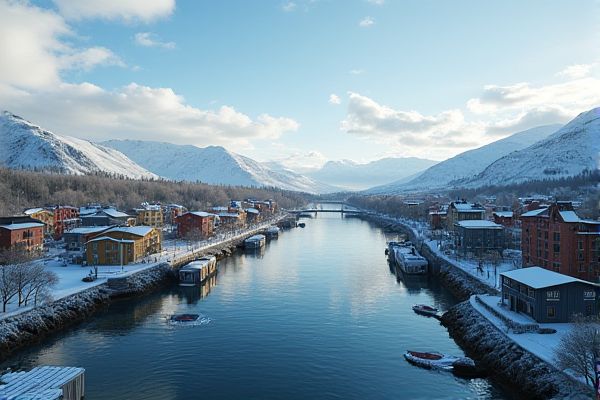
Cost of living in Norway: High average income. Premium healthcare services. Expensive housing options. Costly dining and groceries. Efficient public transportation. Affordable public education. High-quality childcare expenses. Mandatory TV license fee. Energy costs are high. Strong social welfare system.
High average income
In Norway, the average salary is approximately 4,700 euros (55,000 kroner) per month before taxes, which is one of the highest in the world and helps residents cover the high cost of living. High salaries, particularly in sectors like oil production, IT, and the public sector, contribute to the country's stable and comfortable standard of living. For more detailed insights on the cost of living, including expenses like renting an apartment, groceries, transport, and entertainment, you can explore the comprehensive information available on the Visit Ukraine Today Blog.
Premium healthcare services
In Norway, premium healthcare services are largely covered by the public National Insurance Scheme (NIS), but for additional benefits, private health insurance can be purchased. The costs for private insurance average around 508 NOK (56 USD) per month and vary by age, gender, and coverage level. It typically covers services like dental care, private specialist consultations, and psychological care, which may not be fully covered by the public system. For more detailed information, you can visit the comprehensive guide on healthcare at Internations. This ensures that individuals receive a well-rounded healthcare experience, balancing public provisions with personalized options.
Expensive housing options
In Norway, housing costs are notoriously high, especially in urban areas such as Oslo and Tromso, where the average price for residential properties skyrockets, reaching roughly 6.4 million Norwegian kroner in Oslo and nearly 4.6 million in Tromso by March 2024. The expense extends to renting as well, with costs for a one-bedroom apartment averaging between 7,500 and 12,500 NOK per month. Major cities like Oslo and Stavanger are particularly noted for this trend, with security deposits often required amounting to three months' rent. According to Numbeo, the price per square meter in city centers can climb as high as 72,042 NOK, underscoring the financial strain associated with urban living in this Nordic nation.
Costly dining and groceries
Dining and groceries in Norway are exceptionally expensive, with items like chicken breast costing around 100 NOK ($9.10 USD) per kg, and a three-course meal for two at a mid-range restaurant costing approximately 1,000 NOK ($93.30 USD). Groceries, particularly meat, dairy, and vegetables, are pricey due to high taxes and import costs, making them significantly more expensive than in neighboring countries. For more detailed information, visit Supermarket Prices in Norway to explore the factors contributing to this trend.
Efficient public transportation
Public transportation in Norway is highly developed, reliable, and subsidized, featuring a comprehensive network of buses, trains, and ferries. For more information, you can visit the Internations website, which offers insights into living in the country. A monthly public transportation pass costs around 800 NOK (approximately 74.60 USD), making it a more economical option than car ownership, especially given the high costs of fuel, road tolls, and parking.
Affordable public education
In Norway, Public Education is entirely free for all students, including international students, at public universities for undergraduate, postgraduate, and doctoral programs. This generous policy opens doors for students worldwide to pursue their academic goals without the burden of tuition fees. While there are only minor fees for student cards and union memberships, the core educational services remain accessible and free. For more detailed insights, you can visit Norway's Free Education System on the MSM Unify website.
High-quality childcare expenses
In Norway, the maximum fee for kindergarten is capped, currently at NOK 2000 per month for both municipal and private kindergartens. This fee structure ensures affordability and uniformity across different types of institutions. Additional fees may apply for meals, promoting a balanced diet and communal meals for children. Families with lower incomes and those with multiple children are eligible for discounts, offering financial relief and promoting equality in access to early childhood education. For more detailed information on these policies and potential economic adjustments, visit the website for the Oslo Kommune Kindergarten Prices And Payment.
Mandatory TV license fee
In Norway, the TV license fee has been replaced by an income-based tax. As of 2020, individuals pay a tax ranging from 100 NOK to 1,700 NOK per year, depending on their annual income, to fund the Norwegian Broadcasting Corporation (NRK).
Energy costs are high
In Norway, energy costs are exceptionally high, with electricity prices exceeding NOK 13 (EUR 1.12) per kilowatt hour in some regions. This situation is significantly impacting households and businesses, especially in the southern parts of the country. For more detailed insights into this issue, visit the Euro Weekly News website, which provides comprehensive coverage of the ongoing challenges faced by Norwegian consumers and industries due to these steep electricity tariffs.
Strong social welfare system
Norway's strong social welfare system is grounded in the principles of universal entitlements and social and economic equality, providing free or affordable services such as education, healthcare, and various social benefits, including unemployment benefits, child benefits, and disability benefits, all funded through a progressive tax system and general tax revenues. For more details on how these principles are implemented, visit the Norwegian Welfare Model page.
